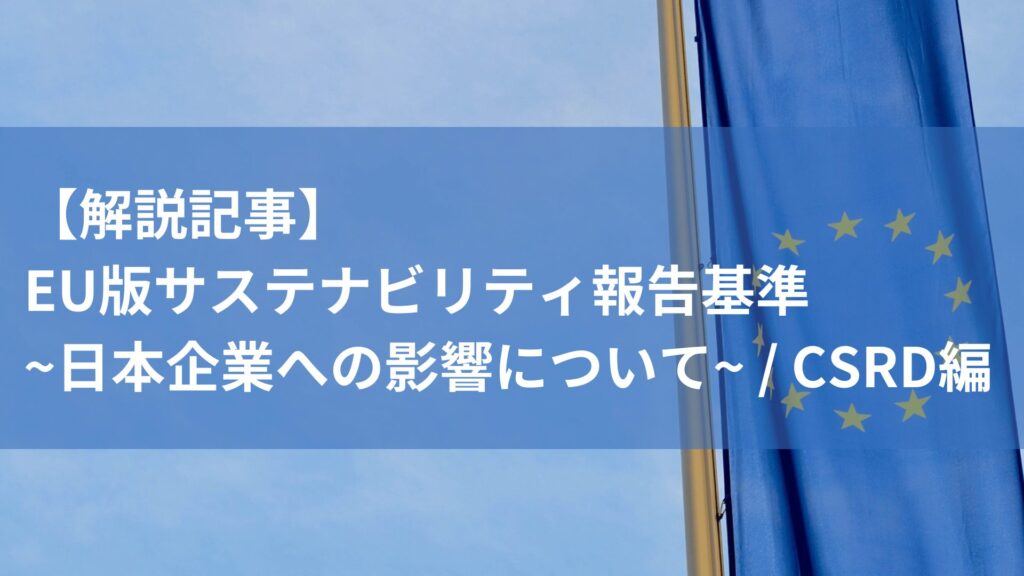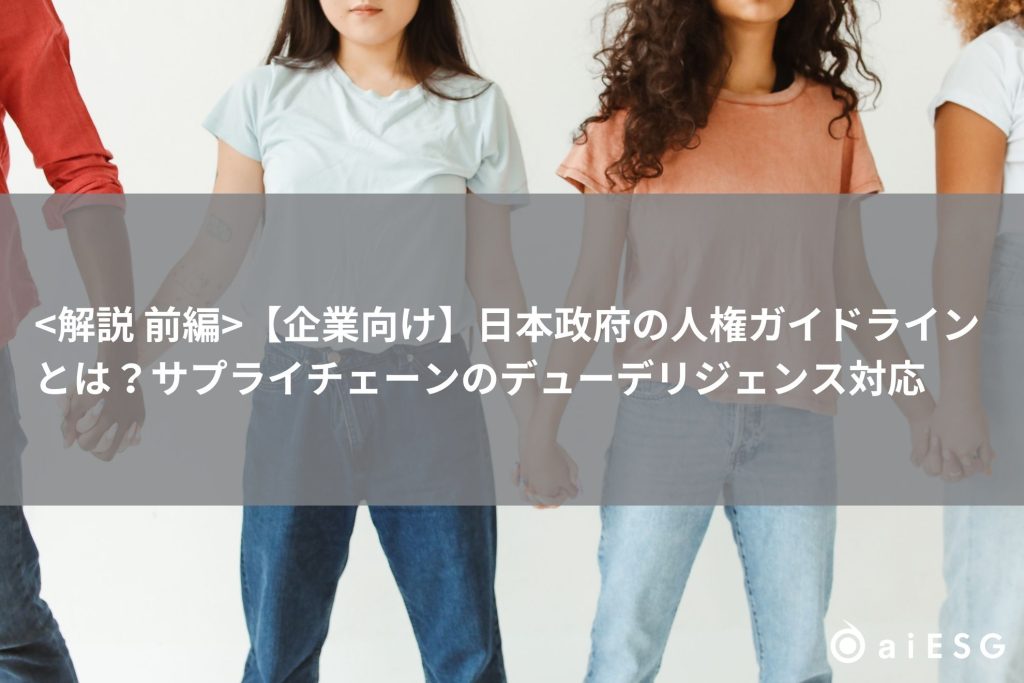INDEX
(Summary)
This article focuses on the Corporate Sustainability Reporting Directive (CSRD) agreed to by the European Parliament and the European Council at the end of 2022, and explains how the CSRD will affect Japanese companies. The presentation will explain how the CSRD will affect Japanese companies.
The CSRD proposes a "general framework concept" for sustainability reporting, which applies to companies both within and outside the EU. This general framework concept refers to "the framework for disclosure information (ESG classifications)" and "the establishment of conditions that form the basis for implementing the Directive," such as "the classification of companies subject to the Directive.
When the general framework is set by the CSRD, detailed disclosure requirements are set separately in a delegated rule called the "ESRS. Therefore, when a Japanese company is subject to CSRD, it is necessary to consider and disclose reports designated by the ESRS, which is based on the general framework of CSRD (ESRS will be explained in the next issue).
Regulatory deadlines: Corporate conditions under the CSRD are classified according to the size of the company. Japanese companies (companies with headquarters in Japan and subsidiary functions in the EU or companies that conduct economic activities in the EU) should be aware of the following "deadlines for disclosure".
Subsidiaries in the EU
1. if subject to the NFRD (Non-Financial Disclosure Directive): applicable from January 1, 2024
2. large group of companies: effective January 1, 2025
3. medium-sized business group: Effective from January 1, 2026
4. small business group: effective January 1, 2026
Even if the company does not have a subsidiary function, if it does business in the EU and meets the prescribed conditions, it is considered a "non-EU entity" and the following deadlines are set:
5. non-EU companies (many Japanese companies with economic activities in the EU): effective from January 1, 2028
The CSRD obliges companies to introduce an "independent assurance system" when disclosing information.
This is a system that requires that the legitimacy of the disclosed information be guaranteed by a third party.
Through the above broad overview, the main measures that are important for Japanese companies to take are as follows
1. identify which group of companies your company is included in
2. if there is a subsidiary in the EU, choose between independent reporting by the subsidiary or consolidated reporting with the head office function
3. secure specialized personnel to oversee sustainability reporting
4. setting up a third party guarantor
In summary, Japanese companies will be subject to the NFRD from fiscal year 2025 at the earliest (if they are not subject to the NFRD), and from fiscal year 2028 at the latest (if they meet the conditions) as non-EU companies.
This article is a lengthy overview, but this article will further elaborate on CSRD according to the following sections.
Table of Contents
(Summary)
1. purpose of establishing CSRD & benefits to the company
2. conditions of the target group of companies
*Mandatory guarantee system
*Electronic tag system
*Cases to be checked on the part of Japanese companies
3. framework for disclosure information
4. relevance of CSRD to other sustainability disclosure indicators
5. summary
1. purpose of establishing CSRD & benefits to the company
The Corporate Sustainability Reporting Directive (CSRD) is a sustainability reporting standard adopted by the European Parliament and the European Commission in 2022, which EU countries are required to regulate through the adoption of national legislation. The reporting requirements set out in the CSRD will be phased in from 2024.
The Non-Financial Reporting Directive (NFRD), which was published in 2014, was the predecessor of sustainability reporting standards in the EU. However, the NFRD set the condition that companies subject to disclosure must be "large companies in the EU with an annual average of more than 500 employees" (approximately 10,000 companies), which resulted in a small number of companies and inadequate quantity and quality of disclosed information. Therefore, the CSRD was adopted as a disclosure directive to make it more reliable and easier to make comparisons backward in time.
Compared to the NFRD, the CSRD covers approximately 50,000 companies (based on the number of companies in the EU alone), a significant increase. In addition, the disclosure requirements have been set to cover ESG (Environmental, Social and Governance) issues.
The CSRD's main objective is to ensure that companies provide comparable and reliable sustainability information for financial institutions, investors, and the general public through more consistent sustainability reporting in the EU.
The following benefits to the company can be expected from CSRD (1) The company will be able to provide a more efficient and effective service to its customers:
Raise awareness among internal and external stakeholders to accelerate not only disclosure but also management transformation and sustainability initiatives.
The CSRD-based reporting is more detailed and comprehensive, and investors and stakeholders have more reliable access to sustainability-related information, which has the effect of stimulating investment and other benefits.
Increased transparency through a better understanding of corporate sustainability strategies and risk management
The CSRD clearly states that disclosure is mandatory not only for companies within the EU, but also for companies outside the EU. Japanese companies doing business in the EU are expected to be required to comply with the CSRD as a regulation that cannot be ignored.
The next section summarizes more detailed conditions for the target group of companies.
2. conditions of the target group of companies
As indicated in the introduction, the CSRD sets disclosure deadlines for companies within the EU by size; the CSRD isWithin the EUAllenterprise, ,SMEs listed on EU regulated markets, ,Non-EU companies with substantial operations in the EUThis applies to three main groups of companies. Listed SMEs are companies whose securities are traded on regulated markets in the EU and do not meet the definition of large companies. While the aforementioned NFRD-eligible companies will still be classified as a large company group, the CSRD will start operating one year earlier than other large companies.
Table 1: CSRD Eligibility Conditions and Target Companies (Prepared by Author)
| Eligibility: At least two of the three requirements must be met for two consecutive fiscal years.*Microenterprises are exempted if they meet two or more of the following requirements | Operation start date | |
| NFRD-eligible companies (large companies) | Listed on EU regulated markets with more than 500 employees and banks, etc. | From January 1, 2024 |
| large-scale | More than 250 employees OR net sales of more than EUR 40 million OR balance sheet total (total assets) of more than EUR 20 million | From January 1, 2025 |
| mid-scale | Less than or equal to 250 employees OR less than or equal to 40 million euro in total sales OR less than or equal to 20 million euro in total balance sheet (total assets) | From January 1, 2026 |
| small scale | Less than 50 employees OR less than 8 million euro in total sales OR less than 4 million euro in total balance sheet (total assets) | From January 1, 2026 |
| Microenterprises (Exemptions) | Less than 10 employees OR less than 700,000 euro in sales OR less than 350,000 euro in total balance sheet (total assets) | No plan to apply (if conditions are met) |
| Non-EU Companies | Prerequisites:The non-EU ultimate parent company's total sales in the EU for the past two consecutive fiscal years exceed €150 million & additional conditions (either one of which must be met): (1) The EU subsidiary is a large or listed company OR (2) The EU branch's total sales in the EU exceed €40 million. | From January 1, 2028 |
*Mandatory guarantee system
The CSRD will gradually make "third-party assurance" in disclosed information mandatory. This is intended to ensure the reliability of the information reported. The European Commission is expected to adopt standards for limited assurance prior to October 1, 2026. It then plans to adopt the reasonable assurance (more extensive audit) standard in October 2028.
*Electronic tag system
The report (in XHTML format) to be produced requires a "tagging" assurance according to a digital classification by using the European Single Access Point (ESAP) model. Through the digitization of information, the project aims to improve data usability and reuse in the financial sector.
*Cases to be checked on the part of Japanese companies
1. Confirmation of Applicability of EU Subsidiary: If an EU subsidiary qualifies as a large company as defined in the CSRD, it will be subject to the CSRD from 2025. In addition, even if the subsidiary is not subject to CSRD operation, if it meets the conditions as a non-EU company, the CSRD operation will start in 2028.
In addition, if a subsidiary is listed on an EU-regulated market, it must also be confirmed as a medium-sized or small group of companies.
2. if a subsidiary in the EU is subject to the CSRD, the following two means of disclosure are considered:
(1) Disclose sustainability reporting based on CSRD by the subsidiary on a stand-alone basis
(2) If the parent company complies with the CSRD for Japanese companies or "discloses sustainability reporting on a consolidated basis based on equivalent standards", the EU subsidiary is exempted from the reporting requirements.
(3) If only the subsidiary in the EU is to respond, check whether the local organization has the necessary resources and experience to disclose sustainability information: If it does not have sufficient resources and experience, it should consider supporting the parent Japanese company or reporting on a consolidated basis.
3. framework for disclosure information
The reporting requirements under the CSRD strengthen corporate disclosure of sustainability information and establish specific reporting requirements. Items to be included in the report are ESG-related information, such as a company's business model, strategy, and environmental and social impacts.
The CSRD is characterized by the introduction of the "double materiality" concept. This is a departure from the "single materiality" standards found in other corporate evaluation standards, which require companies to provide information that may influence investors' decisions by not being disclosed. Double materiality refers to the requirement to disclose not only the impact of sustainability-related matters on a company's business performance and financial condition, but also the impact of corporate activities on the "environment" and "society. and society.
CSRD regulatory matters are established based on the following three ESG factors :
Table 2: ESG Indicators
| Environmental Indicators | social index | Governance Indicators |
| greenhouse gas | Employee Management | Board Composition and Diversity |
| energy | Work Environment and Work-Life Balance | officer's compensation or remuneration |
| Water and Marine Resources | Gender Equality and Equal Pay | risk management |
| natural resources | Supply Chain Management | Governance Structure and Practices |
| pollution | Community Involvement | Lobbying and other political activities |
| biodiversity |
Taking these factors into account, the regulatory requirements in the CSRD are as follows (*The detailed requirements for each item are set by the ESRS, which is a delegated regulation):
Business model and strategy, including risks and opportunities
Targets with timeframes
Roles and necessary expertise and skills of management, supervisory bodies, etc.
Policy
Incentives provided to members of management and supervisory bodies, etc.
Due diligence process, identification of negative impacts in the business and value chain, and actions taken to prevent, mitigate, etc., and results
Major risks and how they are managed
KPI (Key Performance Indicator)
4. relevance of CSRD to other sustainability disclosure indicators
This section is a supplement to the section entitled "Cases in which a Japanese company discloses its sustainability report on a consolidated basis based on an equivalent standard" mentioned in "*Cases to be confirmed by the Japanese company" in "2.
The CSRD (and the Delegated Regulation ESRS) have indicated that they intend to establish "equivalent sustainability reporting requirements," although they have not clarified this at this time. This means that other sustainability regulations that meet the criteria envisioned on the part of the CSRD will be considered equivalent, as follows. (1) Sustainability Reporting Requirements:
Comprehensive coverage of a wide range of sustainability issues
Easily compare sustainability performance across companies
Establish trustworthy measures to ensure the accuracy of the information provided.
Present information in a manner that is easily accessible and understandable to stakeholders.
The CSRD side has identified the ISSB (International Sustainability Standards Board) as a potential equivalence standard evaluation target. Taken in a broader sense, it is envisioned that the scope of these equivalent standards may be expanded to include GRI Standards, SASB Standards, TCFD (Task Force on Climate-related Financial Disclosures), and others. As a cautionary note, it is necessary to consider that these are still "under consideration for finalization" and that the start of the application of the CSRD is imminent.
In addition, Japan is currently considering a domestic sustainability reporting standard based on the ISSB standard, and plans to release the finalized standard by the end of FY2024, so there may be future discussions on whether CSRD is subject to evaluation based on the equivalent standard.
Thus, with regard to the application of CSRD, it is difficult for Japanese companies to decide whether to have CSRD applied or to have other sustainability reporting standards as equivalent standards to be exempted.
5. summary
This article describes the CSRD, the EU version of the Sustainability Reporting Standard, which proposes a broad concept applicable to companies within and outside the EU, with specific disclosure requirements to be set separately by the ESRS. The objective of the CSRD is to provide comparable and reliable corporate sustainability information.
The CSRD applies to companies within the EU, and the start date of application varies depending on the size of the company. It also applies to non-EU companies with substantial operations in the EU. For Japanese companies, it is necessary to check the applicability of the CSRD to their subsidiaries in the EU and the conditions for being a non-EU company, and consider how to respond to the CSRD.
The reporting requirements under the CSRD require disclosure of information from environmental, social, and governance perspectives. In particular, the concept of double materiality will be introduced, whereby companies will disclose not only their business performance and financial position, but also their environmental and social impacts.
Regarding the relevance of CSRD to other sustainability disclosure indicators, the CSRD side has indicated its intention to recognize equivalent standards, but the specific standards are still undecided. For Japanese companies, it is difficult to decide whether to consider applying the CSRD or to receive exemptive responses based on the equivalence of other standards.
aiESG provides support for everything from basic CSRD to actual disclosure of non-financial information, so if your company is having trouble with CSRD, please contact us.
Contact us:
https://aiesg.co.jp/contact/
Related page
What is the SASB Standard for ESG Information Disclosure? (Part 1)Outline of SASB
https://aiesg.co.jp/topics/report/2301025_sasb1/
Explanation] What is TNFD? A new bridge between finance and the natural environment
https://aiesg.co.jp/topics/report/230913_tnfdreport/
















